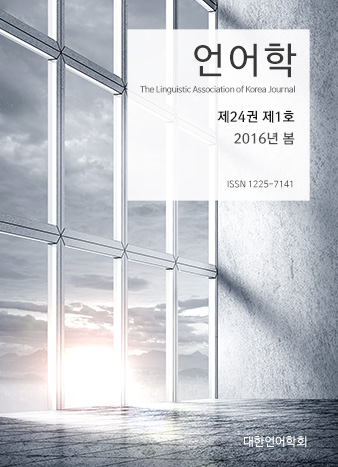대한언어학회 전자저널

24권 1호 (2016년 3월)
- Young Korean Learners' Usage of the Verb give: Evidence from their narratives
-
In Lee
Pages : 21-48
Abstract
Lee, In. (2016). Young Korean learners' usage of the verb give: Evidence from their narratives. The Linguistic Association of Korea Journal 24(1), 21-48. The dative alternation in English caused the learnability paradox and many L1 acquisition researchers have dealt with this topic. The purpose of this study was to find out how young Korean learners of English use the verb give and its construction. My arguments are based on the analysis of 11 children's narratives and their L2 data were collected while each language informant was describing the same wordless picture book, A Circle of Friends by Carmi (2003). The following are the findings: First, it seems that the amount of input bears little or no relation to the usage of the verb give as far as the appropriateness is concerned. Second, 3 informants in the third grade used inappropriate constructions more frequently than appropriate ones (13 versus 7 occurrences). It can be assumed that inappropriate forms like *is give-NP(IO)-NP(DO), *give-NP(DO), or *give-NP(IO), were influenced by their L1. Third, 3 children in Grade 4 began to recognize the verb give as a ditransitive rather than as a transitive, and a prepositional form of the dative alternation was their preference. We can assume that their ill-formed constructions like *is give-NP(DO) (twice), *NP(DO)-and-NP(IO)-is-give, and *NP(DO)-is-NP(IO)-give were the results of L1 transfer. Fourth, 2 children in the fifth grade more frequently used the verb give followed by two objects than the verb followed by a single object (20 versus 12 occurrences). Fifth, it seems that 3 informants in Grade 6 realized the verb give as a ditransitive. The usage of the verb in 2 informants narratives was quite appropriate and stabilized, while 1 informants narratives showed some characteristics of his Interlanguage. Sixth, it seems that Korean child learners regarded an expression like give me money or give to as a chunk.
Keywords
# dative alternation # ditransitive construction # narrative # wordless picture book
References
- Baker, C. L. (1979). Syntactic theory and the projection problem. Linguistic Inquiry, 10, 533-581.
- Carmi, G. (2003). A circle of friends. New York: Star Bright Books.
- Ellis, R., & Barkhuizen, G. (2005). Analysing learner language. Oxford: Oxford University Press.
- Gorpen, J., Pinker, S., Hollander, M., Goldberg, R., & Wilson, R. (1989). The learnability and acquisition of the dative alternation in English. Language, 65(2), 203-257.
- Hong, H.-T. (2003). The English ditransitive construction. The Jungang Journal of English Language & Literature, 45(4), 201-216.
- Jun, J. S. (2006). Lexical derivation of triadic dative verbs in English. Discourse and Cognition, 13(3), 189-207.
- Lee, I. (2008). Development of English coupla be in L2 acquisition. Studies on English Language & Literature, 34(1), 299-319.
- Lee, I. (2010). On the development of elementary school students\\\' narrative competence in English. Primary English Education, 16(3), 7-26.
- Lee, I. (2011). Korean elementary school students\\\' development of English grammar: A case study of two children\\\'s descriptive narratives. Primary English Education, 17(3), 67-90.
- Lee, I. (2014). A Korean child learner\\\'s acquisition of English grammar: A four-year-long case study. The Linguistic Association of Korea Journal, 22(1), 69-110.
- Lee, J. (2009). Transitive of \\\'give\\\' in English. New Korean Journal of English Language & Literature, 51(1), 303-323.
- Lee, J.-H., & Kim, H. M. (2011). The L2 developmental sequence of English constructions and underlying factors. Korean Journal of English Language & Linguistics, 11(3), 577-600.
- Lee, Y. (2011). English and Korean ditransitive constructions. The Journal of Studies in Language, 26(4), 901-919.
- Levin, B. (1993). English verb classes and alternations: A preliminary investigation. Chicago and London: The University of Chicago Press.
- Mayer, M. (1973). Frog on his own. New York: Dial Books for Young Readers.
- Shan, R., & Hong, S. (2009). On ditransitive constructions: A neo-transformational approach. The Journal of Studies in Language, 25(3), 575-599.
- Tak, K. (1999). Ditransitive construction and focus. English Language & Literature, 18(2), 183-198.